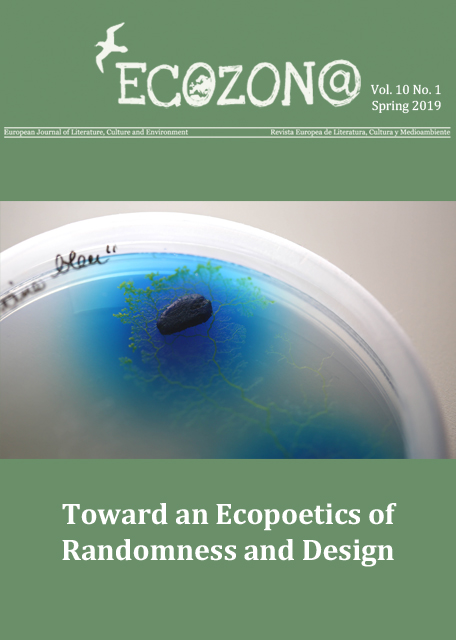<b>Shrieks from the Margins of the Human: Framing the Environmental Crisis in Two Contemporary Latin American Movies</b> // Gritos desde los márgenes de lo humano: Enmarcando la crisis medioambiental en dos películas latinoamericanas contemporáneas
DOI:
https://doi.org/10.37536/ECOZONA.2019.10.1.2657Palabras clave:
Beauty, A decent woman, the more-than-human world, nature/culture, enviromental crisis, Latin American cinema // Nosilatiaj. La belleza, Los decentes, el mundo más que humano, naturaleza/cultura, crisis medioambiental, cine latinoamericanoResumen
The contemporary fictional films Nosilatiaj. La belleza [Beauty] (dir. Daniela Seggiaro, 2012) and Los decentes [A Decent Woman] (dir. Lukas Valenta Rinner, 2016) explore the complex intra-action between the human and the non-human worlds, in this case the animal world and the natural landscape, in the context of environmental crisis. In both movies, images of natural landscapes are accompanied by depictions of class inequalities and the environmental crisis. As fiction, the films present an environmental perspective through a symbolic framing of nature. This highlights the marginal place assigned to the non-human world by progress and development. In Beauty, nature is threatened by deforestation of the dry forest landscape called the Bush or the Gran Chaco. Throughout the film, the landscape is always present in the background, either fragmented or just suggested in the memories and subjectivity of the protagonist, Yolanda, a girl of the Wichí people. A Decent Woman adopts the trope of idyllic nature through a nudist community set in a natural jungle-like area adjacent to a gated community for wealthy residents. Belén, the protagonist, a maid working in the gated area, begins participating in the nudists’ rituals. Employing posthuman and new materialist theories, the article analyzes scenes from both movies that foreground the interactions between the human and the more-than-human world in the light of the threats to the natural ecosystem. We discuss the framing of the environmental crisis through the intervention of animals and the animalization of characters, which exemplify the haunting presence of a receding but resistant nature. While nature vanishes from the screen—it is either cut out for agriculture or for ornamental parks in private neighborhoods—the viewers are placed in an active position that prompts ethical thinking concerning the environment.
Resumen
Las películas de ficción contemporáneas Nosilatiaj. La belleza [Beauty] (2012) de Daniela Seggiaro y Los decentes [A Decent Woman] (2016) de Lukas Valenta Rinner exploran las complejas intra-acciones entre el mundo humano y el mundo más que humano, en este caso el mundo animal y el paisaje natural, en el contexto de la crisis ambiental. Como películas de ficción, la perspectiva ambiental se presenta a través de tomas fílmicas donde la naturaleza adquiere significados simbólicos, destacando así el lugar marginal asignado al mundo no-humano por el progreso y el desarrollo. En Nosilatiaj. La belleza la naturaleza está amenazada por la deforestación y es evocada en la narrativa por el paisaje del Monte chaqueño argentino. A lo largo de la película, el paisaje siempre está latente, enrevesado con los recuerdos y la subjetividad de la protagonista, Yolanda, una niña del pueblo Wichí. Los decentes adopta el tropo de la naturaleza idílica a través de la presencia de una comunidad nudista en un área verde similar a la jungla adyacente a una comunidad cerrada para residentes de clase alta. Belén, la protagonista, una empleada doméstica que trabaja en el barrio cerrado, comienza a participar en los rituales de la comunidad nudista en ese entorno natural. Empleando teorías sobre el materialismo posthumano y el neomaterialismo, el objetivo de este artículo es analizar escenas en ambas películas que ponen de relieve las interacciones entre las formas de vida humana y más que humana, explorando cómo este tema se retrata a la luz de la amenaza a respectivos ecosistemas. Discutimos los encuadres de la crisis ambiental a través de la intervención de animales y de la animalización de los personajes en las películas, que prefigura la inquietante presencia de una naturaleza que retrocede, pero resiste. Al desvanecerse la naturaleza de la pantalla?es podada para la agricultura o para parques ornamentales en barrios privados?analizamos cómo el espectador va ganando una posición más activa que exige un gesto ético hacia la crisis medioambiental.
Descargas
Descargas
Archivos adicionales
Publicado
Número
Sección
Licencia
Authors who publish with this journal agree to the following terms:
a) Authors retain copyright and grant the journal right of first publication with the work simultaneously licensed under a Creative Commons Attribution License that allows others to share the work with an acknowledgement of the work's authorship and initial publication in this journal (CC BY-NC for articles and CC BY-NC-ND for creative work, unless author requests otherwise.
b) Authors are able to enter into separate, additional contractual arrangements for the non-exclusive distribution of the journal's published version of the work (e.g., post it to an institutional repository or publish it in a book), with an acknowledgement of its initial publication in this journal.
c) Authors are permitted and encouraged to post their work online (e.g., in institutional repositories or on their website) prior to and during the submission process, as it can lead to productive exchanges, as well as earlier and greater citation of published work (See The Effect of Open Access).










